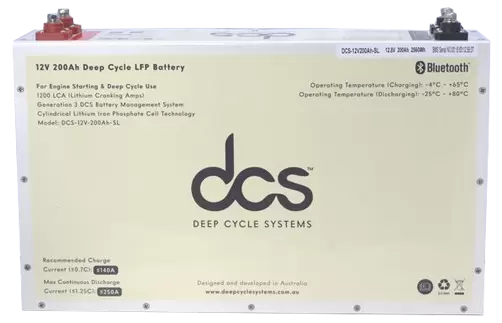Understanding the fundamentals of your lithium marine battery is crucial for its longevity and optimal performance. Lithium-ion marine batteries boast high energy density and lighter weight, unlike traditional lead-acid batteries, making them ideal for marine applications. Their ability to handle deep cycles more efficiently also means they can be discharged and recharged multiple times without significant degradation. They come in various capacities and sizes, catering to various marine needs. Recognising these attributes helps you make informed decisions about your battery’s usage and care. This foundational knowledge is the first step in ensuring your battery remains reliable and functional.
Routine Maintenance for Your Lithium Battery
Routine maintenance is essential for ensuring the longevity and efficiency of your lithium battery. Regularly inspect the battery for wear, corrosion, or physical damage. Clean the terminals and connectors to prevent the build-up of dirt and corrosion, which can affect performance. If necessary, check the battery’s voltage and charge levels periodically, using a voltmeter to ensure it remains within the recommended range. Ensure the battery remains securely fastened to prevent any movement that could cause damage.
Additionally, periodically balance the cells if your battery management system (BMS) allows it, as this helps maintain uniform performance across all cells. Ensure all cables and connections are intact and free from fraying or other damage. If you notice any irregularities, address them promptly to prevent further issues. Finally, keep the battery in a dry, cool place when unused, and ensure it is charged appropriately during storage to avoid degradation. This consistent attention to detail will help maintain the battery’s reliability and efficiency over time.
Correct Installation of Lithium Ion Marine Batteries
Proper installation of Lithium Ion Marine Batteries are essential for their longevity and performance. When done correctly, it ensures that the battery operates efficiently and remains safe throughout its lifespan.
Consult Manufacturer’s Guidelines
Start by reviewing the manufacturer’s instructions for specific battery installation requirements. Following these guidelines will help avoid common mistakes and ensure compatibility with your equipment.
Secure and Ventilated Placement
Place the battery in a well-ventilated area to prevent overheating. It should be securely fastened to avoid movement, which could cause damage or lead to safety hazards.
Correct Terminals and Connections
Use the correct terminals and connectors, ensuring they are tight and corrosion-free. Loose connections can lead to short circuits and inefficiency.
Proper Cable Sizing
Ensure all cables are of the correct gauge and length. This minimises resistance and prevents power loss, helping to maintain the battery’s efficiency.
Polarity and Safety Measures
Check the polarity to prevent any damage to the battery or connected equipment. Installing a fuse or circuit breaker will protect the battery from potential overcurrent situations, enhancing safety.
Following these steps ensures that your lithium-ion marine battery will perform optimally and safely, providing reliable power for your aquatic adventures.
Enhancing Charging Methods for Extended Battery Life
Proper charging methods are essential for extending the lifespan of your lithium battery. First and foremost, always use a charger specifically designed for lithium-ion marine batteries. An incompatible charger can lead to overcharging or undercharging, significantly reducing the battery’s lifespan. Charge the battery in a well-ventilated area to allow for adequate heat dissipation, preventing overheating. Overheating can damage the battery and reduce its efficiency. It’s also crucial to avoid charging the battery in extremely hot or cold conditions, as temperature extremes can affect its ability to charge efficiently.
Monitoring the charging process is equally important. Once the battery reaches full capacity, ensure it is not charged for extended periods. Overcharging can lead to excessive heat generation and potential damage. Using chargers with automatic shut-off features or charge controllers can prevent overcharging. These devices automatically stop charging once the battery is fully charged, ensuring it remains at optimal charge levels.
Periodically checking the battery’s voltage and state of charge is another vital practice. Regular monitoring allows you to identify any irregularities early and take corrective actions before they escalate into major issues. Maintaining a consistent charging schedule also helps ensure the battery remains in good health. Implementing these practices will preserve your lithium battery’s overall health and efficiency and provide reliable performance over a more extended period.
Adhering to these guidelines can maximise the longevity of your battery, reduce the need for frequent replacements, and enjoy reliable performance during your marine adventures. Proper care and attention to charging methods are investments in your lithium battery’s long-term efficiency and durability.
Controlling Temperature for Efficient Lithium Battery Use
Managing the temperature of your lithium battery is vital for ensuring its efficiency and longevity. Extreme hot or cold temperatures can adversely affect the battery’s performance and lifespan. Ideally, aim to keep the battery within the recommended operating temperature range specified by the manufacturer. During usage, ensure the battery is adequately ventilated to dissipate heat generated from high currents. In colder climates, consider using insulation or a battery heater to maintain optimal temperatures, preventing the battery from becoming too cold and losing efficiency. Regularly monitor the battery’s temperature using built-in sensors if available, and adjust your usage patterns to avoid temperature extremes.
Additionally, avoid placing the battery near engines or other heat sources that could raise its temperature beyond safe limits. Proper temperature management enhances performance and reduces the risk of thermal runaway, a dangerous condition where the battery can overheat uncontrollably. Implementing these measures helps maintain your lithium battery’s health and operational reliability.
Keeping Track of Lithium Ion Marine Battery Performance
Regularly monitoring your lithium-ion marine battery’s performance ensures its reliability and longevity. A battery management system (BMS) effectively tracks essential parameters such as voltage, current, and state of charge. The BMS provides real-time data, allowing you to identify any irregularities or potential issues early, thus preventing costly damage.
Review the Lithium Ion Marine Battery performance metrics periodically, especially after extensive or prolonged storage. Logging this data can help you spot trends or declines in performance over time, enabling you to take proactive measures. Additionally, take advantage of any diagnostic tools or software the battery manufacturer provides. These tools can offer in-depth insights into the battery’s health and performance, helping you make informed decisions about its usage and maintenance.
For a more comprehensive approach, incorporate regular inspections into your routine. Check for physical signs of wear and tear, such as cracks in the battery case or corrosion on the terminals. Clean the terminals and connections with a soft cloth to ensure they remain debris-free, which can impair performance. Monitoring the battery’s voltage and state of charge regularly will help you detect any irregularities early, allowing for timely interventions.
Moreover, maintaining the appropriate temperature conditions for your battery is vital. Extreme temperatures can affect the battery’s performance and lifespan, so it is advisable to keep it in a controlled environment whenever possible. By integrating these practices into your routine, you can extend the life of your lithium-ion marine battery, ensuring reliable and efficient performance for years to come. Implementing these monitoring and maintenance practices is an investment in your battery’s long-term health and reliability.
Environmental Impact and Disposal of Lithium Marine Batteries
The environmental impact and proper disposal of lithium batteries are crucial considerations for eco-conscious users. Lithium batteries contain hazardous materials that can harm the environment if disposed of incorrectly. When a lithium battery reaches the end of its life, it should be taken to a certified recycling facility. These facilities are equipped to handle and process the materials safely, extracting valuable metals and ensuring that harmful substances do not contaminate the environment. Many manufacturers and local authorities offer battery recycling programmes, making it easier for users to dispose of old batteries responsibly.
Additionally, consider choosing batteries from manufacturers that follow sustainable practices and provide take-back schemes. Properly recycling lithium marine batteries mitigates environmental harm and supports the recovery and reuse of valuable resources, contributing to a more sustainable future. Always check local regulations and guidelines for battery disposal, as these can vary by region and may offer specific instructions or services to facilitate safe recycling.
Conclusion
Extending the lifespan of your lithium marine battery involves several key practices. Start by understanding its unique attributes, which differ from traditional batteries. Ensure correct installation by following manufacturer guidelines and securing the battery in a well-ventilated location. Regular maintenance is essential; inspect for wear, clean terminals, and balance cells as needed. Employing proper charging methods is crucial; use chargers designed for lithium batteries and avoid extreme temperatures during charging. Temperature control is another vital aspect; managing heat and cold is essential to maintaining battery efficiency. Regular performance monitoring using a battery management system allows you to catch irregularities early.
Frequently Asked Questions
How often should I inspect my lithium marine battery?
It’s recommended that you inspect your lithium marine battery every month for signs of wear, corrosion, or physical damage. Regular checks help maintain optimal performance and identify issues early.
Can I use any charger with my lithium battery?
No, using a charger specifically designed for lithium-ion marine batteries is crucial. Using an incompatible charger can lead to overcharging or undercharging, which may damage the battery.
What is the ideal temperature range for operating my lithium battery?
The ideal temperature range varies by manufacturer but is generally between 0°C and 40°C. Always refer to the manufacturer’s guidelines for your battery model’s specific operating temperature range.
How do I dispose of a used lithium battery?
Used lithium batteries should be taken to a certified recycling facility. Many manufacturers and local authorities offer recycling programmes to help dispose of old batteries responsibly.
Is it normal for my lithium battery to lose efficiency over time?
Yes, all batteries experience some level of efficiency loss over time. However, proper maintenance, correct charging methods, and temperature control can significantly extend the lifespan of your lithium battery.
| Related Business Listings |
| Contact Directory |
| Local Business Profiles |



